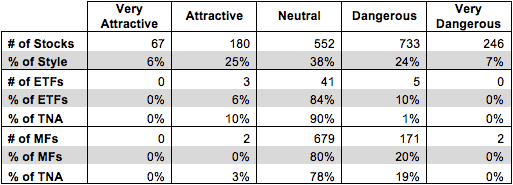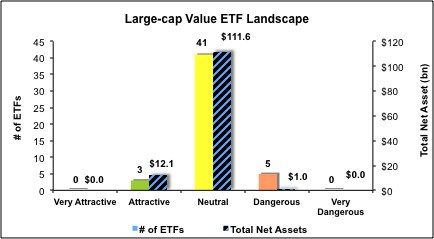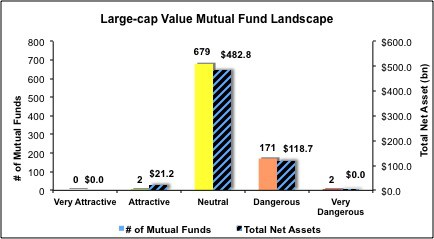The Large Cap Value style ranks second out of the twelve fund styles as detailed in my Style Rankings for ETFs and Mutual Funds report. It gets my Neutral rating, which is based on aggregation of ratings of 49 ETFs and 854 mutual funds in the Large Cap Value style as of April 16, 2014. Prior reports on the best & worst ETFs and mutual funds in every sector and style are here.
Figures 1 and 2 show the five best and worst-rated ETFs and mutual funds in the style. Not all Large Cap Value style ETFs and mutual funds are created the same. The number of holdings varies widely (from 19 to 1404), which creates drastically different investment implications and ratings. The best ETFs and mutual funds allocate more value to Attractive-or-better-rated stocks than the worst, which allocate too much value to Neutral-or-worse-rated stocks.
To identify the best and avoid the worst ETFs and mutual funds within the Large Cap Value style, investors need a predictive rating based on (1) stocks ratings of the holdings and (2) the all-in expenses of each ETF and mutual fund. Investors need not rely on backward-looking ratings. My fund rating methodology is detailed here.
Investors seeking exposure to the Large Cap Value style should buy one of the Attractive-or-better rated ETFs or mutual funds from Figures 1 and 2.
Get my ratings on all ETFs and mutual funds in this style by searching for Large Cap Value on my mutual fund and ETF screener. For more products, click here.
Figure 1: ETFs with the Best & Worst Ratings – Top 5
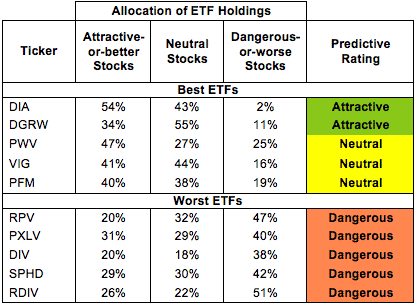 * Best ETFs exclude ETFs with TNAs less than $100 million for inadequate liquidity.
* Best ETFs exclude ETFs with TNAs less than $100 million for inadequate liquidity.
Sources: New Constructs, LLC and company filings
First Trust First Trust Capital Strength ETF (FTCS), First Trust NASDAQ Rising Dividend Achievers ETF (RDVY), and iShares NYSE 100 ETF (NY) are excluded from Figure 1 because their total net assets (TNA) are below $100 million and do not meet our liquidity standards.
Figure 2: Mutual Funds with the Best & Worst Ratings – Top 5
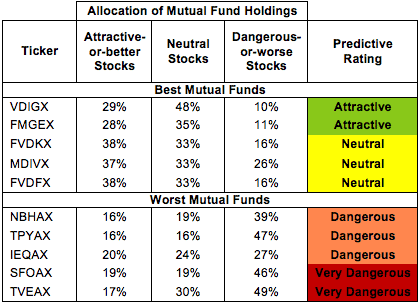 * Best mutual funds exclude funds with TNAs less than $100 million for inadequate liquidity.
* Best mutual funds exclude funds with TNAs less than $100 million for inadequate liquidity.
Sources: New Constructs, LLC and company filings
Managed Portfolio Series: Coho Relative Value Equity Fund (COHOX) and Investment Managers Series Trust: Oak Ridge Dividend Growth Fund (ORDNX) are excluded from Figure 2 because their total net assets (TNA) are below $100 million and do not meet our liquidity standards.
State Street SPDR Dow Jones Industrial Average ETF (DIA) is my top-rated Large Cap Value ETF and Vanguard Specialized Funds: Vanguard Dividend Growth Fund (VDIGX) is my top-rated Large Cap Value mutual fund. Both earn my Attractive rating.
RevenueShares Ultra Dividend Fund (RDIV) is my worst-rated Large Cap Value ETF and Transparent Value Trust: Transparent Value Dividend Fund (TVEAX) is my worst-rated Large Cap Value mutual fund. RDIV earns my Dangerous rating and TVEAX earns my Very Dangerous rating.
Figure 3 shows that 247 out of the 1778 stocks (over 31% of the market value) in Large Cap Value ETFs and mutual funds get an Attractive-or-better rating. However, only 3 out of 49 Large Cap Value ETFs (less than 10% of total net assets) and 2 out of 854 Large Cap Value mutual funds (less than 3% of total net assets) get an Attractive-or-better rating.
The takeaways are: mutual fund managers allocate too much capital to low-quality stocks and Large Cap Value ETFs hold poor quality stocks.
Figure 3: Large Cap Value Style Landscape For ETFs, Mutual Funds & Stocks
As detailed in “Low-Cost Funds Dupe Investors”, the fund industry offers many cheap funds but very few funds with high-quality stocks, or with what I call good portfolio management.
Investors need to tread carefully when considering Large Cap Value ETFs and mutual funds, as very few receive an Attractive or better rating. Only 3 ETFs and 2 mutual funds in the Large Cap Value style allocate enough value to Attractive-or-better-rated stocks to earn an Attractive rating.
DirecTV (DTV) is one of my favorite stocks held by Large Cap Value ETFs and mutual funds and earns my Very Attractive rating. Over the past seven years, DTV has grown after-tax profits (NOPAT) by 14% compounded annually. DTV currently earns a top quintile return on invested capital (ROIC) of 20% and has generated positive economic earnings in each of the past seven years. The stock is up 24% since we first recommended DTV to investors in September, but the stock price still doesn’t reflect the true value of DTV. At its current valuation of ~$75/share, DTV has a price to economic book value (PEBV) ratio of 1.0. The ratio implies the market expects DTV to never grow NOPAT for the remainder of its corporate life. DTV has proven over the years their ability to consistently grow NOPAT, and should easily surpass such low expectations.
FirstEnergy Corporation (FE) is one of my least favorite stocks held by Large Cap Value ETFs and mutual funds and earns my Dangerous rating. Over the past nine years, FE’s NOPAT has declined by 1% compounded annually. The company currently earns a bottom quintile ROIC of 2% and hasn’t generated positive economic earnings in any of the last 16 years. FE has dropped 25% over the past year, but its weak fundamentals means it could have farther to fall. To justify its current price of ~$34/share, FE would need to grow NOPAT by 11% compounded annually for the next 15 years. For a Utility company, especially one with declining profits over the past nine years, that expectation seems unrealistic.
Figures 4 and 5 show the rating landscape of all Large Cap Value ETFs and mutual funds.
My Style Rankings for ETFs and Mutual Funds report ranks all styles and highlights those that offer the best investments.
Figure 4: Separating the Best ETFs From the Worst Funds
Figure 5: Separating the Best Mutual Funds From the Worst Funds
Review my full list of ratings and rankings along with reports on all 49 ETFs and 854 mutual funds in the Large Cap Value style.
To protect your portfolio from the worst ETFs and mutual funds, click here for a free trial.
Kyle Guske II contributed to this report.
Disclosure: David Trainer and Kyle Guske II receive no compensation to write about any specific stock, sector, style or theme.

